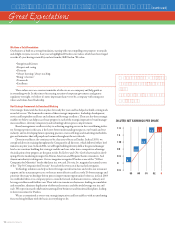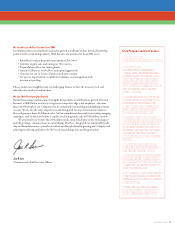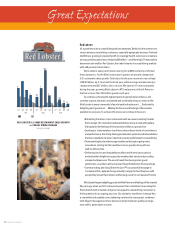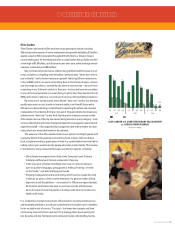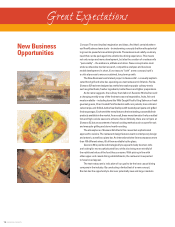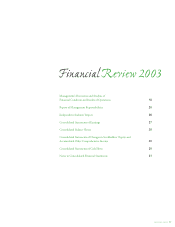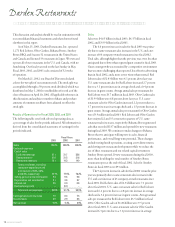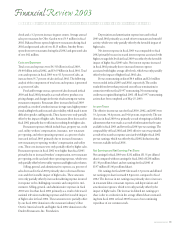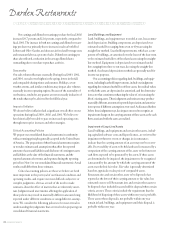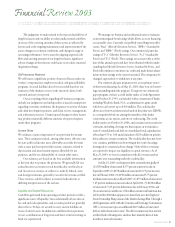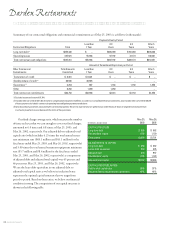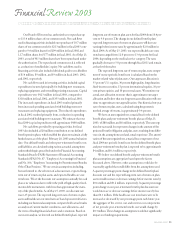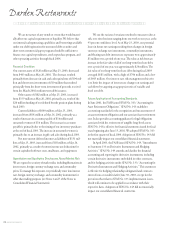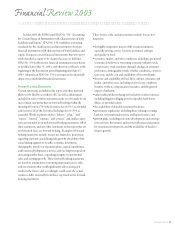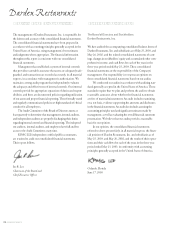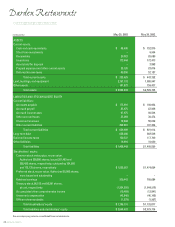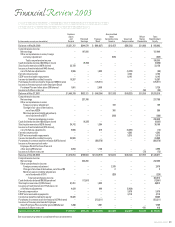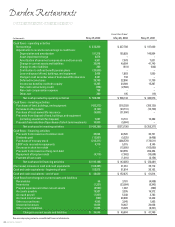Red Lobster 2003 Annual Report Download - page 22
Download and view the complete annual report
Please find page 22 of the 2003 Red Lobster annual report below. You can navigate through the pages in the report by either clicking on the pages listed below, or by using the keyword search tool below to find specific information within the annual report.
20 DARDEN RESTAURANTS
Net earnings and diluted net earnings per share for fiscal 2002
increased 20.7 percent and 22.6 percent, respectively, compared to
fiscal 2001. The increase in both net earnings and diluted net earn-
ings per share was primarily due to increases in sales at both Red
Lobster and Olive Garden and decreases in food and beverage costs
and restaurant labor as a percent of sales. Diluted net earnings per
share also reflected a reduction in the average diluted shares
outstanding due to our share repurchase activities.
Seasonality
Our sales volumes fluctuate seasonally. During fiscal 2003, 2002,
and 2001, our sales were highest in the spring, lowest in the fall,
and comparable during winter and summer. Holidays, severe
weather, storms, and similar conditions may impact sales volumes
seasonally in some operating regions. Because of the seasonality of
our business, results for any quarter are not necessarily indicative of
the results that may be achieved for the full fiscal year.
Impact of Inflation
We do not believe inflation had a significant overall effect on our
operations during fiscal 2003, 2002, and 2001. We believe we
have historically been able to pass on increased operating costs
through menu price increases and other strategies.
Critical Accounting Policies
We prepare our consolidated financial statements in conformity
with accounting principles generally accepted in the United States
of America. The preparation of these financial statements requires
us to make estimates and assumptions that affect the reported
amounts of assets and liabilities and disclosure of contingent assets
and liabilities at the date of the financial statements, and the
reported amounts of revenues and expenses during the reporting
period (see Note 1 to our consolidated financial statements). Actual
results could differ from those estimates.
Critical accounting policies are those we believe are both
most important to the portrayal of our financial condition and
operating results, and require our most difficult, subjective or
complex judgments, often as a result of the need to make
estimates about the effect of matters that are inherently uncer-
tain. Judgments and uncertainties affecting the application of
those policies may result in materially different amounts being
reported under different conditions or using different assump-
tions. We consider the following policies to be most critical in
understanding the judgments that are involved in preparing our
consolidated financial statements.
Land, Buildings, and Equipment
Land, buildings, and equipment are recorded at cost, less accumu-
lated depreciation. Building components are depreciated over
estimated useful lives ranging from seven to 40 years using the
straight-line method. Leasehold improvements, which are a com-
ponent of buildings, are amortized over the lesser of the lease term
or the estimated useful lives of the related assets using the straight-
line method. Equipment is depreciated over estimated useful
lives ranging from three to ten years also using the straight-line
method. Accelerated depreciation methods are generally used for
income tax purposes.
Our accounting policies regarding land, buildings, and equip-
ment, including leasehold improvements, include our judgments
regarding the estimated useful lives of these assets, the residual values
to which the assets are depreciated or amortized, and the determina-
tion as to what constitutes enhancing the value of, or increasing the
life of, existing assets. These judgments and estimates may produce
materially different amounts of reported depreciation and amortiza-
tion expense if different assumptions were used. As discussed further
below, these judgments may also impact our need to recognize an
impairment charge on the carrying amount of these assets as the cash
flows associated with the assets are realized.
Impairment of Long-Lived Assets
Land, buildings, and equipment and certain other assets, includ-
ing capitalized software costs and liquor licenses, are reviewed for
impairment whenever events or changes in circumstances
indicate that the carrying amount of an asset may not be recover-
able. Recoverability of assets to be held and used is measured by a
comparison of the carrying amount of the assets to the future net
cash flows expected to be generated by the assets. If these assets
are determined to be impaired, the impairment to be recognized
is measured by the amount by which the carrying amount of the
assets exceeds their fair value. Fair value is generally determined
based on appraisals or sales prices of comparable assets.
Restaurant sites and certain other assets to be disposed of are
reported at the lower of their carrying amount or fair value, less
estimated costs to sell. Restaurant sites and certain other assets to
be disposed of are included in assets held for disposal when certain
criteria are met. These criteria include the requirement that the
likelihood of disposing of these assets within one year is probable.
Those assets whose disposal is not probable within one year
remain in land, buildings, and equipment until their disposal is
probable within one year.
Darden Restaurants
ManagementÕs Discussion and Analysis of Financial Condition and Results of Operations


